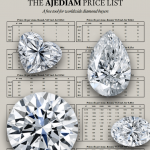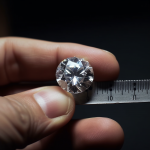Diamond Prices
Read moreThe Excelsior Diamond
A Rare Tragedy Among Famous Gemstones
The Excelsior diamond, initially weighted at an astounding 995 carats, was once the largest gem-quality diamond in the world. The name Excelsior, meaning ‘ever higher’, underlines the high hopes that the diamond’s founders had for the diamond’s future. Yet, these dreams of fame were dashed. Only ten years after it was found, the diamond was cut into 21 pieces, yielding a parcel that consisted of several smaller pieces and one bigger stone weighing only 69.69 carats.
The significance of this loss does not bear lightly in the minds of industry specialists. Rendering what seemed like crumbs, the cleaving resulted in multiple meager fractions of the original, huge rough stone. Some dub the decision to cut the diamond ‘the greatest tragedy of modern times, in the history of diamonds’.
If you’d like to learn more about the Excelsior diamond, in this article you will find:

- Discovered in
- June 30, 1893
- Country of Origin
- South Africa
- Mine of Origin
- Jagersfontein Mine
- Carat Weight
- 995.2 carats
- Cut Shape
- Cut into 21 pieces; one piece weighs 69.69 carats
- Clarity
- Original diamond had black carbon inclusions
- Excelsior I (certified in 1991) VS-2
- Color
- Original diamond graded G (near colorless)
- Excelsior I (certified in 1991) - G
- Previous Owners
- Jagersfontein Mining and Exploration Company Limited
- London consortium
- Messrs. Wernher Beit & Co.
- Tiffany & Co.
- De Beers Company
- Graff Diamonds Ltd.
- Current Owner
- Robert Mouawad (Excelsior I)
- Estimated Value
- Excelsior I purchased for $2,642,000 in 1996
The Origins of the Excelsior diamond
The discovery of the Excelsior Diamond
On the 30th of June of 1893, a South African mine worker was attending to his daily duties. The Jagersfontein mine, where he was shoveling gravel into a truck, was located only 130km southeast of the prominent Kimberley mine. The Jagersfontein had always been considered a mining location of secondary importance.
Yet, amid the dirt, the worker found a rough diamond the size of half a loaf of bread. Among the debris, dashes of light, dressed in a blue-white color shone through. The gemstone stood taller than any diamond ever found, which inspired the name ‘Excelsior’. When the worker made the discovery, he hid the stone from his overseer, fearing that he wouldn’t receive the credit he deserved. The worker took the diamond directly to the mine manager, who rewarded him for his honesty with £500 and a saddled horse.
The ownership of the Excelsior Diamond:
The consortium
On the date of the discovery, the leasing contract for the mine was going to expire. The contract was signed between the Jagersfontein mining company and a buying consortium of ten London firms. The overseer of the worker who found the stone could have hidden the diamond for a day and in this way, the mining company could have claimed full ownership. However, due to the honesty of the worker, who immediately reported the find, the company had to settle for 50%, sharing the rest of the profit with the consortium. Nonetheless, the diamond was shipped to Britain, where it was subsequently insured by the consortium and was locked away in a secure vault.
In 1896, the mining company agreed to sell its shares to the consortium, and in particular to the companies Messrs. Wernher Beit & Co., Barnato Bros., and Mosenthal Sons & Co. for a price of £25000 which is about £638,285 considering the current inflation rates.
No buyers for the Excelsior are found
The London consortium of companies patiently awaited a buyer for the Excelsior Diamond. However, the sheer size, quality, and price scared off most buyers. Ten years after the diamond’s discovery, there was still no buyer to be found. Thus, in 1903, the companies resorted to the services of the Dutch Royal Asscher Diamond company. When Asscher inspected it, he reportedly found that the diamond contained black carbon inclusions, which were typical for diamonds hailing from that mine, but thwarted all hopes for producing a large, record-setting, high-quality gem.
The cutting of the Excelsior Diamond
The dramatic decision was then made to cut the Excelsior into smaller pieces, and sell them separately. Asscher sealed the diamond’s fate by cutting it into 21 exquisite gems which ranged from 69,69 carats to less than one. The combined weight of the finished gemstones was 373.75 carats, which amounted to a loss of about 63% of the gemstone’s original mass. Even though the loss was enormous, the result exceeded the expert’s original expectations. Due to the presence of the dreaded carbon inclusions, they feared the final product was going to yield an even less substantial result.
Critiques of the Excelsior’s cutting
The venture seemed to grow into a debacle. The General Manager of De Beers company Alpheus Williams commented on the event in his book “Some Dreams Come True”. According to Williams, the cutting of the Excelsior was ‘the biggest tragedy of modern times in the history of diamonds’. To provide some context for comparison, the fate of the Jubilee Diamond was to become two stones, the larger weighing 245.35 carats. The Jubilee was found a few years after the Excelsior in the same mine, but it became the sixth-largest polished diamond in the world at the time. It seems that the re-cutting of the piece was not as well received by history as it was by its spectators back then.
The modern ownership history of The Excelsior Diamond
Whereabouts and original owners
The Excelsior was originally discovered in the Jagersfontein mine in South Africa. Half of it became the property of the Jagersfontein Mining and Exploration Company Limited. The other half belonged to a diamond-buying consortium in London of more than 10 companies. The biggest of them was Messrs. Wernher Beit & Co. In 1896 Messrs. Wernher Beit & Co., Barnato Bros., and Mosenthal Sons & Co. bought the shares of the Jagersfontein mining company. In 1903 the Excelsior was sent to be cut into high-quality gemstones in Amsterdam.
Different Jewels, Different Owners
Following the Excelsior’s cut, it was separately sold to different buyers, some of whom remained anonymous. Three gems were sold to Tiffany & Co. The De Beers Company displayed one of the smaller marquise-shaped pieces at the New York World Fair in 1939. In 1989 Graff Diamonds Ltd. purchased the Excelsior I from an unknown family and then re-sold it to an anonymous client. The diamond was then up for sale in 1991 and 1996, when it was finally purchased by Robert Mouawad for $2,642,000 for his private collection.
Unfortunately, the history of the other Excelsior Diamond pieces is shrouded in mystery. Some experts believe that the Excelsior IV might have been exhibited at ‘The Court of Jewels’ in Texas, in 1949, by Harry Winston. The jewel had the correct shape, size, and measurements. Later in 1957, a pear-shaped pendant that weighed 46.50 carats was auctioned by the Parke-Bernet Galleries. It’s possible that this was the Excelsior III.
The technical characteristics of the Excelsior Diamond
Originally, the Excelsior weighed 971 old carats, which were equivalent to 995.2 metric carats which amount to 199 grams. The diamond’s shape was flat at the bottom and rose into a peak, similar to a mountain or half a loaf of bread. Its crystalline structure was akin to a fractured icicle. It measured 21⁄2 by 2 inches by 1 inch thick.
The Excelsior diamond possessed a blue-white color, graded G, which means near colorless. It is a characteristic of some of the finest quality diamonds. However, it contained several black carbon inclusions. That forced Asscher to cut the rough gem into smaller higher-quality stones.
The color and clarity grades for each piece of the Excelsior diamond are unavailable. This is because many of their buyers have remained anonymous. However, the GIA certified the Excelsior I in 1991. It gave the stone a grade of VS-2 clarity and a color grade of G. This means the stone is very slightly included and nearly colorless.
The significance of the Excelsior Diamond
With a weight of 995.2 carats, the Excelsior was once the largest rough diamond in the world. Unfortunately, it is largely associated with its cutting, widely considered a misjudgment; instead of its original caliber which embodied its full potential. Nonetheless, by today’s standards, it is still the 4th largest diamond of gem quality ever found. The Excelsior diamond rightly belongs to the family of the largest world-famous diamonds, such as the Cullinan.
If it was still whole today it would be worthy of expositions in the most exquisite of museums around the world, as the gigantic, dazzling wonder of nature it once was. However, it was cut into 21 pieces and sold to different buyers which sealed its fate into obscurity. Perhaps Alpheus Williams was correct in his critique. The decision to cut the Excelsior diamond robbed all humanity of the gemstone’s brilliance.
We hope you enjoyed the read!
If you’d like to read about other famous diamonds like the Orlov, Eureka, or Premier Rose diamonds, you can visit Ajediam’s Famous Diamonds glossary. Or, if you’re feeling inspired, you can browse Ajediam’s premium diamond collections shop.



